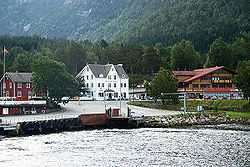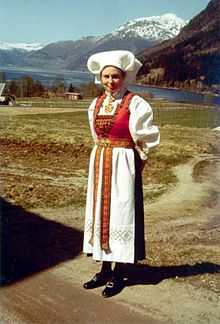Kinsarvik
| Kinsarvik kommune | |
|---|---|
| Former Municipality | |
 | |
| Country | Norway |
| County | Hordaland |
| District | Vestlandet |
| Municipality ID | NO-1231 |
| Adm. center | Kinsarvik |
| Population (1963) | |
| • Total | 1,585 |
| Created from | Kinsarvik formannskapsdistrikt in 1838 |
| Merged with | Ullensvang in 1964 |
Kinsarvik (pop: 459) is a village, and former municipality, in the county of Hordaland, Norway.
Kinsarvik was established as a municipality January 1, 1838 (see formannskapsdistrikt). Ullensvang used to be an annex to Kinsarvik - but in 1869 Ullensvang became the main parish, and Kinsarvik became an annex to Ullensvang. (And the municipality then changed the name to Ullensvang.) Kinsarvik and Odda were separated from Ullensvang as municipalities of their own July 1, 1913. Most of Kinsarvik was again merged with Ullensvang January 1, 1964.
The village is today the administrative center of Ullensvang - and it is located at the mouth of the Sørfjorden and the Eidfjorden where it branches from the Hardangerfjord.
The Village of Kinsarvik
Church
The Kinsarvik church was built in 1160 and is one of the oldest stone churches in Norway. In the Middle Ages the Kinsarvik Church was the site of a market, legal magistrates, as well as a religious center. In the winters the ship masts and sails of the area were stored in the church attic. In the reformation the church decorations were whitewashed but 1961 the church was restored to its Catholic appearance including a fresco of the Archangel Gabriel weighing souls.
Huse Valley
It is the wild Kinso river that gives name to Kinsarvik. Its name stems from "kinn" which means "steep mountainside," so "Kinsarvik" is simply "The Bay of Kinso". The Kinso River drops 3600 feet from the Hardangervidda through the Huse valley (Husedalen) to sea level in the fjord at Kinsarvik. Along the way there are 4 spectacular waterfalls. The waterfalls can be viewed in 4–6 hours by hiking. The trails are slippery when wet.
-

Tveitafossen falls, 338 feet
-

Nyastølfossen falls, 591 feet
-

Nykkjesøyfossen falls, 160 feet
-

Søtefossen falls, 807 feet
Kinsarvik is also a major access point for longer treks across the Hardangervidda, Norway's largest national park.
Hardanger Bestikk
The Hardanger Bestikk factory has been producing cutlery (flatware) in Kinsarvik since 1958.[1] The factory employs about 50 persons.[2]
Tourism

The history of Kinsarvik tourism has been one of dramatic changes. Up until the 1970s the village was the busiest ferry port in Norway and a crucial junction on the only all-year road connecting Bergen and Oslo. Alternative routes then eroded its importance, but in 2006 the Norwegian Parliament approved the Hardanger Bridge, a monumental bridge project only 12 km from Kinsarvik which was completed in 2013 and reestablished inner Hardanger as a dominant route and tourist stop for both east-west and north-south traffic.
Kinsarvik functions as a base camp for tourists visiting the surrounding areas and has several camping grounds and a hotel. Kinsarvik Båthavn is a small marina.
The shores of the fjords in this area are thick with fruit trees, primarily cherry and apple trees. There are spikes in tourism for the flowering and harvest of these trees.
History
Vikings
In the time of Julius Caesar a clan known as Charudes was reported to live in the Jutland region of Denmark. The people were reported to be involved in many battles and thereby had a tradition of warfare. About the time of the fall of Rome and the arrival of the Huns there was a great movement of people in Europe. The Charudes were squeezed between the Angles, Saxons, and the Jutes. It has been theorised that the clan, which was by now referred to as Horder or Harding left Denmark and settled in Scotland, Iceland and the area around what is now Kinsarvik, setting up an independent kingship. The county of Hordaland and the region of Hardanger are thought to be named for this people.
The shores of the Hardangerfjord are steep and rocky. The gradual earthen banks at the mouth of the Kinso River were an important place for the building and repair of the Longship. Any attack on Kinsarvik would have to be made by ship. The area was backed by the glaciers of the Hardangervidda and on the east any land force would have to go around the long, narrow, and deep waters of the Sørfjord or Eidfjorden. It was an ideal defensive position for Vikings.
Christianity

Christianity arrived in the 11th century, and a wooden church was built at Kinsarvik, which was an important economic centre in the region of inner Hardanger. In 1160, a stone church was erected in its place.
Christianity also brought English settlers with Apple rootstock. The English also brought the art of grafting to the fruit industry of Hardanger about 1300. The area around Kinsarvik is well suited for growing fruit and its practice expanded.
By 1536 the Protestant Reformation was underway. The first church in Norway to convert was in Ullensvang just a few miles from Kinsarvik. At this time the paintings and frescos of the Kinsarvik church were covered. In the 17th century the woodwork of the church was painted. In 1961 the original frescos were uncovered.
Sámi
Archaeological studies have shown that reindeer and the hunting of reindeer on the Hardangervidda was well established in the iron (Viking) age and Middle Ages.[3]
However, the current reindeer herds on the Hardangervidda plateau do not origin from the old Reindeer population which occupied all the high plateaus in pre-historian times, but is a result of early 1900 initiatives with reindeer herding on the Hardangervidda. For this both reindeer and sami (herders) were brought to the area. The reindeer herdring on the Hardangervidda did not succeed and the reindeers either escaped or were let loose. Some of the Sami herders settled down in Kinsarvik, but more so in Eidfjord - one of the bordering counties.
| Wikimedia Commons has media related to Kinsarvik. |
External links
- http://www.ullensvang.herad.no
- http://home.c2i.net/campingguiden/Hordaland/ullensvang/ullensvang.html
- http://84.205.39.225/view/index.shtml
- http://book.bestwestern.com/bestwestern/productInfo.do?iata=&promoCode=&corpID=&propertyCode=73013#null
- http://www.google.com/maps?f=q&hl=en&ie=UTF8&om=1&qmo=ms&dq=kinsarvik&near=&oq=kinsarvik&z=11&ll=60.403341,6.731873&spn=0.150573,0.461426
- http://www.hardanger-bestikk.no/
- http://www.hardangertun.no/familieparken/fKrasjbatar.htm
References
- ↑ Johannes Sekse (18 November 2013) Gaffeljubileum i Norge Rundt Hardanger Folkeblad. Retrieved 19 October 2013 (Norwegian)
- ↑ Mariel Mellingen (12 July 2009)Kineserne vil ta over industri-Norge TV2. Retrieved 19 October 2013 (Norwegian)
- ↑ Reinsdyr og reinsdyrfangst på Hardangervidda i jernalder og middelalder Bergen Museum. Retrieved 19 August 2013 (Norwegian)
Harding, Stephen E. (2002). "Viking Mersey: Scandinavian Wirral, West Lancashire and Chester"
Birkely, H. (1994). "I Norge har lapperne først indført skierne", Indre Billefjord: I ut
http://www.nottingham.ac.uk/-sczsteve/Harding.htm King Harding
Coordinates: 60°22′28″N 6°43′12″E / 60.37444°N 6.72000°E